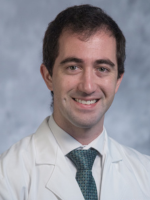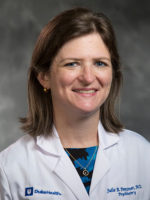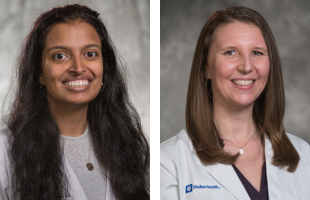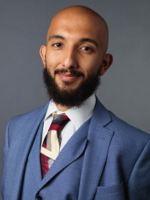
Although acute care psychiatrist Christopher Ramsay, MD, doesn’t work with children, he’s grateful for the child and adolescent psychiatry training he received during his psychiatry residency at Duke. He joined the Duke Psychiatry & Behavioral Sciences faculty after completing his training in 2024, and he’s already reaping the benefits of having prior experience working with children. “It’s been super helpful, even in just a few months of being an adult psychiatrist,” he said.

Ramsay said he’s recognized on many occasions how this training enhances his clinical practice, but one particular case stands out. He recalls one young adult patient he diagnosed with autism, who presented with behaviors that could have suggested other conditions. He attributed his ability to accurately diagnose the patient to his residency rotation in the Duke Autism Clinic. He reflected, “Through that experience, I learned so much more about how it presents and what it could look like, and I understand more than just the criteria in the diagnostic manual.”
During his residency, Ramsay also spent time on the child and adolescent inpatient service at Central Regional Hospital, in a Duke clinic for children with both medical and behavioral health concerns, and at Duke’s Counseling and Psychological Services, where students can receive behavioral health care.
Bolstering Residency Opportunities
In recent years, Duke child and adolescent psychiatry fellowship and psychiatry residency leaders have worked to bolster the training requirements and elective opportunities to care for pediatric patients.

“In the past, we had fewer required pediatric psychiatry experiences for residents. They worked in the inpatient and emergency department settings, as well in our family therapy clinic.,” said Tara Chandrasekhar, MD, program director of the child and adolescent psychiatry fellowship.
Now, these opportunities abound. In addition to rotating for several months in the Family Studies Clinic, residents are required to spend a similar amount of time in one of several pediatric outpatient clinics. They also rotate in the pediatric emergency department for a few weeks and complete a one-month rotation on the pediatric consult-liaison service, where they give behavioral health consultations with patients, families, and care teams of children hospitalized for medical conditions.
“We’re always doing continuous quality improvement in the residency to make sure we provide the strongest experiences in every area, and we have an incredibly strong faculty in child psychiatry at Duke.”
— Julie Penzner, MD

“We’re always doing continuous quality improvement in the residency to make sure we provide the strongest experiences in every area, and we have an incredibly strong faculty in child psychiatry at Duke,” noted Julie Penzner, MD, vice chair for education and acting program director of the psychiatry residency. Adding more child-focused rotations to the program better leverages the department’s faculty expertise, while also giving residents a more well-rounded training experience during a time when many of them are not settled on a specific path within psychiatry.
Providing Even Earlier Exposure
Early exposure to child and adolescent psychiatry is critical to recruiting more medical students and residents into the field, said Chandrasekhar, because it helps them understand more concretely what the work looks like and helps them envision themselves potentially pursuing child psychiatry.
To that end, starting in January 2025, Duke Psychiatry & Behavioral Sciences began offering a pediatric psychiatry consultation-liaison elective for fourth-year Duke medical students. Students in the elective will gain experience across different levels of care. They’ll help conduct evaluations of children and adolescents across the emergency department and inpatient medical floors, collaborating with interdisciplinary teams to support the care of pediatric patients with complex presentations. They’ll also spend time in behavioral health outpatient clinics.

Established and led by assistant professors Aishwarya Rajagopalan, DO, MHS, and Rebecca Taylor, MD, the course is the first medical student psychiatry elective at Duke focused on children and adolescents. It’s designed not only for students interested in psychiatry, but also for those who intend to work with children and families in other medical specialties.
“A lot of the people who will be providing frontline care will be our pediatrics, family medicine, emergency medicine, and internal medicine colleagues,” noted Rajagopalan. “And if they can learn some of the basics of psychiatry and behavioral health, they may be able to fill some of the gaps we’re facing [in behavioral health care access].”
“A lot of the people who will be providing frontline care will be our pediatrics, family medicine, emergency medicine, and internal medicine colleagues. And if they can learn some of the basics of psychiatry and behavioral health, they may be able to fill some of the gaps we’re facing [in behavioral health care access].”
— Aishwarya Rajagopalan, DO, MHS
Inspiring Future Child Psychiatrists
These gaps are significant; across the U.S., there are only 15 practicing child and adolescent psychiatrists per 100,000 children, and 72 percent of U.S. counties have no child and adolescent psychiatrists. Given this shortage, part of the goal in offering more opportunities to work with children, and doing so earlier in the course of training, is to inspire medical students and residents to consider this career path.

For Duke psychiatry resident Adam Howard, MD, ScM, an elective on a pediatric inpatient psychiatry unit while he was a fourth-year student at the Mayo Clinic Alix School of Medicine ignited that spark of inspiration. “I had very positive views of child psychiatry from that experience,” he reflected. “I wasn’t 100 percent sure whether or not I would do a child fellowship, but I would say it was more likely than not.”
During his residency, in addition to completing the child-focused requirements, he took advantage of other opportunities to work with children, including moonlighting at Central Regional Hospital and Duke’s new Pediatric Emergency Department Extension Area. He has enjoyed these experiences so much that he decided to apply to “fast-track” into Duke’s child and adolescent psychiatry fellowship after completing only three of the four years of residency.
“Whatever [a child is] going through is so fresh. It’s not been there for 40 years. You can see those little cracks in the shell of defense and know that because those cracks are there, healing is possible. There’s hope every day.”
— Adam Howard, MD, ScM
“Whatever [a child is] going through is so fresh. It’s not been there for 40 years,” Howard reflected. “You can see those little cracks in the shell of defense and know that because those cracks are there, healing is possible. There’s hope every day.”
Howard matched with Duke’s child and adolescent psychiatry fellowship earlier this month, along with his fourth-year co-resident, Lara Thibodeau, MD.
Enhancing Behavioral Health Care for Adults
In pursuing child and adolescent psychiatry, Howard and Thibodeau are more exceptions than the norm. Most medical students and residents aren’t going to choose that career, but diverse training opportunities with this population can also help psychiatrists provide better care for adults, as Ramsay has observed.
“We know that many mental health conditions start in childhood or adolescence and persist throughout life, so understanding the developmental trajectories of conditions, what they can look like early on and how they can influence that person’s experience as an adult is really meaningful.”
— Tara Chandrasekhar, MD
“We know that many mental health conditions start in childhood or adolescence and persist throughout life,” noted Chandrasekhar. “So understanding the developmental trajectories of conditions, what they can look like early on and how they can influence that person’s experience as an adult is really meaningful.”
Chandrasekhar added that working with children, even more so than with adults, requires thinking deeply about the systems at play for patients—for instance, how the family dynamic is working, how the child is interacting with school, and how the child is socially connected with others. This thought process, she said, helps cultivate a more holistic approach in caring for patients of any age.
According to Penzner, residents have embraced the enhanced child and adolescent psychiatry requirements and electives, and recent graduate Ramsay now knows from experience that this training truly makes a difference for adult psychiatrists. “I’m really excited for the increased access the residents are getting to child training,” he shared. “They’re going to make better physicians later.”